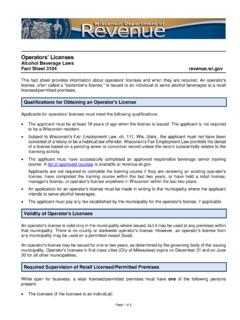Transcription of Midterm 2 exam solutions Please— do not read or discuss ...
1 CS 161 Computer SecuritySpring 2010 Paxson/WagnerMT2 SolnsMidterm 2 exam solutionsPlease do not read or discuss these solutionsin the exam room while others are still takingthe 161, Spring 2010, MT2 Solns1 Problem 1. [True or false] (14 points)(a)TRUEor FALSE: If Alice has a message to send to Bob and she wants to encrypt the message usingasymmetric cryptography so that no one other than Bob can read it, she does so by using Bob s publickey.(b)TRUEor FALSE: SSL and TLS provide essentially the same end-to-end security properties.(c) TRUEorFALSE: Properly used, a MAC provides both confidentiality and integrity.
2 (d) TRUEorFALSE: DNSSEC uses SSL between different name servers to certify that the results of DNSqueries match those that the name servers are authorized to provide.(e)TRUEor FALSE: In the United States, if a company posts a privacy policy on their web site and failsto comply with it, they can be prosecuted for false advertising.(f) TRUEorFALSE: An attraction of public key cryptography is that, if implemented properly, the algo-rithms generally run much faster than those for symmetric key cryptography.(g) TRUEorFALSE: Memory protection, as found in a typical operating system, prevents malicious coderunning in kernel mode from writing to application-owned 2.
3 [Multiple choice] (18 points)(a) TLS uses the following cryptographic techniques:(i) Asymmetric-key cryptography.(ii) Symmetric-key cryptography.(iii) Cryptographic hash functions.(iv) PKI certificates.(v) Nonces.(vi) None of the above.(b) Which of the following properties must a cryptographic hash function provide?(i) Key revocation.(ii) Collision resistance.(iii) A deterministic mapping from input to output.(iv) One-to-one mapping of input to output.(v) Difficulty of finding an input that matches a given hash.(vi) None of the above.(c) What risks arise when using the same key to encrypt both directions of a communication channel, thataren t present if using different keys for the different directions?
4 (i) Message tampering by flipping bits in the ciphertext.(ii) Reflection attacks.(iii) Hash collisions.(iv) Eavesdropping attacks.(v) Denial-of-service.(vi) None of the 161, Spring 2010, MT2 Solns2(d) As we saw in class, WEP is vulnerable to active attacks that allow an active attacker to flip bits in theciphertext and thereby cause unauthorized modifications to the message received by the recipient. Whatwould be the best defense against this kind of attack?(i) Use a different key for each direction and for each wireless device.(ii) Protect the ciphertext using a MAC.(iii) Encrypt using AES in Cipher Block Chaining (CBC) mode.
5 (iv) Encrypt using AES in Electronic Code Book (ECB) mode.(v) Prepend a random 32-bit nonce to the packet before applying the CRC and encrypting 3. [Terminology] (14 points)1. The security goal of ensuring that a communication arrives at the recipient in a form identical to whatthe sender :Message A widely used, standardized symmetric key encryption A way of checking whether the private key matching the public key in a certificate has been compro-mised and so the certificate should no longer be :Revocation A symmetric-key algorithm for ensuring that a message has not been tampered The amount of uncertainty that an attacker faces when trying to guess an unseen An approach by which users can build up a degree of confidence in a public key s validity withoutrequiring a trusted root of An algorithm for digitally signing data with a private key such that anyone with possession of thecorresponding public key can verify the A signed statement by a trusted authority that a given public key indeed belongs to a given A value used in symmetric key
6 Cryptography to ensure that a new session that transmits the same textas a previous session does not result in identical :IV. (Nonce is also acceptable.)10. A way of constructing a stream cipher, given a block :Counter The notion that the security of a well-designed cryptography algorithm should not rely upon thesecrecy of the algorithm itself but only on the secret keys it :Kirchoff s A widely used, standardized cryptographic hash A Unix operating system mechanism that enables a program to execute with the privileges of a differ-ent user identity rather than the identity of the user who invoked the A trusted third party who provides a way for one party to learn the public key of another party.
7 Webbrowsers have a list of these trusted third parties, to support communication using :Certificate 161, Spring 2010, MT2 Solns3 Problem 4. [Cryptography] (15 points)(a) SuperMail wants every email to be authenticated and protected from modification or tampering whileit is transit from the sender to the receiver. Suppose Alice is sending an emailMto Bob. GivenSuperMail s design constraints, which of the following options would be a secure way to protect theauthenticity and integrity of her email?(i) Alice s software should encryptMunder Bob s public key.
8 In other words, Alice s software shouldsendEKB(M)to :Encryption does not provide authenticity/integrity. Anyone can send such a ciphertext.(ii)Alice s software should sendMalong with a digital signature onMusing Alice s private key. Inother words, Alice should sendM,SignK 1A(M).(iii) Alice s software should choose a new symmetric keykfor this email, send an encryption ofkunder Bob s public key, and also send an encryption ofMunderkusing a stream cipher such asRC4. In other words, Alice should sendEKB(k),M RC4(k).Comment:Encryption does not provide authenticity/integrity. Anyone can send such a , it s vulnerable to message modification (flip bits in the second part of the packet).
9 (iv) Alice s software should choose a new symmetric keykfor this email, send an encryption ofkunder Bob s public key, and also send an encryption ofMunderkusing AES in CBC mode. Inother words, Alice should sendEKB(k),AES-CBC-Encryptk(M).Comment:E ncryption does not provide authenticity/integrity. Anyone can send such a , it is vulnerable to message modification: modifying the last 128 bits of the packet disruptsonly the last 128 bits of the message that Bob receives, and Bob won t detect that the message wastampered with. This violates the message integrity goal.(v) Alice s software should choose a new symmetric keykfor this email.
10 Then it should send fourpieces of information: the messageM, a MAC onMunder the keyk, an encryption ofkunderBob s public key, and a digital signature onkusing Alice s private key. In other words, Aliceshould sendM,MACk(M),EKB(k),SignK 1A(k).Comment:Once Bob receives one such message, he can send forged messages to Carol and makeCarol think Alice sent them. For instance, Bob can sendM ,MACk(M ),EKC(k),SignK 1A(k)toCarol, and Carol will accept this thinking it came from , the signature onkmight reveal the value ofk. Digital signature schemes are not guaranteedto provide confidentiality protection for the message that was signed.






